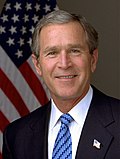Bahrain–United States Free Trade Agreement
 From Wikipedia - Reading time: 7 min
From Wikipedia - Reading time: 7 min
| |
|---|---|
| Type | Free trade agreement |
| Drafted | September 14, 2004 |
| Signed | September 14, 2004 |
| Location | Washington, D.C., United States |
| Effective | August 1, 2006 |
| Condition | 2 months after notification of each state that all internal procedures have been completed |
| Ratifiers | |
| Languages | |
 | |
| Long title | To implement the United States-Bahrain Free Trade Agreement. |
|---|---|
| Enacted by | the 109th United States Congress |
| Citations | |
| Public law | Pub. L. 109–169 (text) (PDF) |
| Legislative history | |
| |
The United States–Bahrain Free Trade Agreement (USBFTA) is a free trade agreement (FTA) between the United States and Bahrain, signed on September 14, 2004. It was ratified by the United States House of Representatives on December 7, 2005, by 327–95, with 10 not voting.[1]
The United States Senate approved the bill on December 13, 2005, by voice vote. President George W. Bush signed the USBFTA Implementation Act into law (Pub. L. 109–169 (text) (PDF)) on January 11, 2006.[2][3] The FTA was implemented on August 1, 2006, and will reduce certain barriers of trade between the two countries.[4]
Early stages of the Bahrain–U.S. free trade negotiations go back to the year 1999, with the signing of a Bilateral Investment Treaty (BIT), which entered into force May 31, 2001. It is the first such treaty signed between the United States and a member of the GCC, and is aimed at stimulating the flow of private investment between the two countries. Both parties agreed that a stable framework for investment would maximize effective utilization of economic resources and improve living standards. One year later, a Trade and Investment Framework Agreement (TIFA) was signed on June 18, 2002, representing the prelude for the FTA negotiations. The TIFA was designed as a forum for an ongoing bilateral dialogue on economic reform and trade liberalization.
See more
[edit]References
[edit]- ^ Becker, Elizabeth (May 28, 2004). "U.S. and Bahrain Reach A Free Trade Agreement". New York Times.
- ^ "Bahrain Pact Signed by Bush". New York Times. Reuters. January 12, 2006.
- ^ "Statement on H.R. 4340, "U.S.-Bahrain Free Trade Agreement Implementation Act" (January 11, 2006)". The White House of President George W. Bush. Retrieved July 22, 2014.
- ^ "Statement of USTR Susan C. Schwab Regarding Entry Into Force of the U.S. -Bahrain Free Trade Agreement (July 2006)". Office of the United States Trade Representative. Archived from the original on August 3, 2014. Retrieved July 22, 2014.
External links
[edit]- Final text of the U.S.–Bahrain Free Trade Agreement, Office of the United States Trade Representative
- H.R. 4340 on GovTrack.us
- Bush's Presidential Proclamation on the Implementation of the USFTA
- "U.S.–Bahrain Free Trade Agreement: Potential Economywide and Selected Sectoral Effects", U.S. International Trade Commission, October 2004
- Congressional Research Service Report on Bahrain FTA
- Citizens' Trade Campaign Site on Bahrain FTA
- U.S. Senate Finance Committee Hearing on Bahrain FTA
- U.S. House Ways and Means Committee Hearing on Bahrain FTA
- Testimony on Bahrain FTA of David Hamod, National U.S.-Arab Chamber of Commerce
 KSF
KSF
